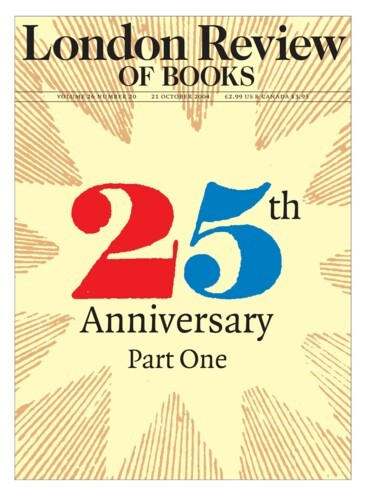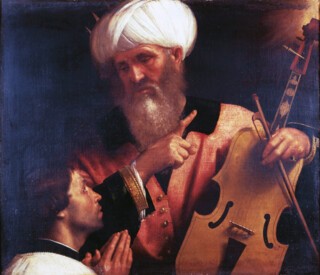The National Gallery of Scotland is now linked with the Royal Scottish Academy building. You can enter by the restaurant which lies between the two buildings at a lower level, or through the portico of either neoclassical structure. The RSA provides a large space for major loan exhibitions, and since these have surpassed in appeal the quieter pleasures provided by the permanent collections, it is appropriate that its rather gross architecture stands in front of the more reticent and elegant home of the parent institution. But The Age of Titian, an exhibition devoted to Venetian Renaissance art mainly from Scottish collections, is so well conceived and displayed that it disarms those of us who trembled at the prospect of change to the arrangements here. There are paintings transported from obscurity, rescued from store or transformed by cleaning; but, best of all, familiar masterpieces appear in a new light.
One of the masterpieces owned by the Duke of Sutherland which has been in Edinburgh on loan for over half a century, Titian’s painting of the Virgin seated in a landscape and watched by the suntanned Baptist as she hands the infant Christ to a kneeling figure in a dark purple robe (implausibly identified as Joseph in the catalogue), is here surrounded by five other paintings by his pupils, assistants and imitators – all of similar format and pastoral character – which, in addition to demonstrating his influence, make clear the intelligence of Titian’s dramatic sense and the delicacy of his handling. The painting from Glasgow, which is especially close in composition to the Edinburgh Virgin, is here, sensibly, given to Titian’s brother Francesco – an attribution that was advanced by Charles Ricketts in his neglected monograph of 1910. His keen eye also recognised the figure of Jerome as the work of Titian himself. The exhibition provides the perfect opportunity to verify this.
Unlike most other exhibitions of 16th-century Venetian paintings in recent decades this one includes sculpture, drawings and prints and, unlike all the others, it includes the decorative arts, with examples of the bronze andirons and door knockers, printed books and luxury glass vessels for which the city was famous. These occasionally colour our experience of the paintings. It is a pleasure to find, below the National Gallery of Scotland’s great Adoration of the Kings by Jacopo Bassano, a pair of stools richly carved with scrolls, which not only evoke the type of frame that might originally have surrounded the painting, but may even be considered as an abstract or epitome of Bassano’s tightly interlaced composition, with the browns, yellows and whites of the painting matched by the partly gilded and silvered walnut.
In another room, however, daylight has been cut out to protect some fragments of old velvet, although the Veroneses also displayed there – especially the Baptism from the Getty Museum in which the flesh tones are carefully related to the pale rose, yellow and white draperies – lose much of their magic when seen by artificial light. The Getty painting is a puzzle. Christ has both arms outstretched, as if he were standing on a tightrope, while the Baptist, above him on the riverbank, twists and leans equally precariously – both figures are at once stabilised and dramatised by the leaning trees behind. The composition would be far more successful if Veronese had not included the usual attendant angels, two of whom impede the sweeping movement of the figures. Did he add them, or allow them to be added, because he wanted more colour, or because his patron insisted on their presence?
In the final room of the exhibition, devoted to portraits of the eminent and elderly made in the twilight of the 16th century, there are some fine heads by Tintoretto, stuck onto dummies and furnished with accessories (a chair, curtains, columns), to which he can have devoted very little time or effort – if he didn’t delegate the work to an assistant who was paid by the yard. Titian’s Allegory of Prudence, that strange painting of three heads from the National Gallery in London, is a more problematic case of a painting in which one part only, the central head, is worthy of the artist. The catalogue assigns the whole painting to Titian, however, and also defends Panofsky’s notion that the central head is that of Titian’s son Orazio: it may ‘plausibly be argued’, we read, that it is ‘compatible with’ the portrait of Orazio as he appears in the wax roundel in the exhibition – a good point if we knew that Orazio was in the habit of dying his beard.*
The Duke of Sutherland’s great Titians of Diana and Actaeon and Diana and Callisto make more of an impression in their usual home in the National Gallery of Scotland, and would make even more of an impact there if they were hung in greater isolation. Here they are stifled by large pictures of lesser quality, although the juxtapositions are instructive. Turning from Paris Bordone’s Christ and the Centurion, in which 15 large, gaudily dressed figures are penned into a narrow strip of foreground space and another half-dozen float in a line in the middle distance, to Diana and Actaeon, in which each of the eight figures occupies a different plane, we are made acutely aware of Titian’s masterly use of pictorial space. After the repetition of expression and limited range of gestures in Bordone, the variety in both the faces and the bodies painted by Titian is especially striking. Diana and Callisto has as its neighbour Andrea Schiavone’s Infancy of Jupiter, the artist’s ‘largest known mythological work’, which has an easy cursive arrangement of figures but a woolly softness in the forms and a weakness in the extremities (especially in the feet, which a restorer in a previous century understandably concealed). Titian’s treatment of the landscape is remarkably similar to Schiavone’s and his figures are also arranged in a fluent chain: but one he breaks for dramatic effect. Titian’s brushstrokes sometimes seem, like Schiavone’s, to distance or decompose the world they describe, but in some passages they suddenly resolve into solid flesh, into feet and buttocks which press against the bank of the stream.
With these great Titians fresh in our minds it’s hard to accept that the subordinate heads in the Allegory of Prudence are by him. As for the Salome from the Koelliker collection – a very little-known painting – it may indeed be of ‘much higher quality’ than was supposed before cleaning, but the heroine’s face is flaccid in modelling and unfocused in expression. In the room devoted to portraiture there is a painting of two patrician boys with dark eyes and earnest frowns which was sold from the Pesaro collection (where it was not highly valued) early in the 19th century. This picture was hung near Titian’s Ranuccio Farnese in the Royal Academy’s exhibition a dozen years ago and the claim that it was by Titian died on the lips of its admirers. Here, however, the heads are said to be ‘certainly the work of the master’.
Despite the doubtful nature of these claims there is more to learn here than in all the other exhibitions on and around Titian which have been mounted by larger and richer institutions. The Bordone and the Schiavone are among these artists’ most ambitious works and neither has been discussed before now by modern scholars. They are hung in the large central room together with other little-known large paintings which were also probably made for the portego or large central hall of Venetian palaces. (In such paintings the lighting would correspond with that of the room: thus those on the wall to the left of the window overlooking the canal would be lit from the right, as is the case with the Bordone and the Schiavone.) In no earlier exhibition has the importance of this class of painting been made apparent.
Peter Humfrey, one of the exhibition’s curators, has also discovered a portrait by Lorenzo Lotto (a rather sad picture from the artist’s tired last years in Venice, and not in very happy condition, but all the same a touching work by a very great artist) and he has made many new and convincing attributions (to Maganza, Domenico Capriolo, Giovanni da Asola and Paolo Fiammingo). These will not be the works which detain visitors longest, but each one makes a real contribution to the effect of the exhibition. One unfamiliar painting is hard to leave behind. This is the extraordinary picture of King David holding a lira da braccio and looking down on a priest who kneels in prayer before him: a work recognised by Mina Gregori as by Moretto nearly twenty years ago, and which has not been seen in public in Britain for two hundred years. It was once attributed to Guercino, which is understandable since the type of the bearded and turbaned king, his gentle solicitude, the discreet radiance and the soft glow on the faces are reminiscent of that artist’s quieter late works. The palette is now more restrained than Moretto intended, for the rose has faded in the regal tunic and the green darkened in the sleeve and collar, but this may well enhance the effect of the light which falls from top right and is reinforced by David’s emphatically pointing hand, exactly on a diagonal and in the centre of the canvas. Preparations for the exhibition (which closes on 5 December) have entailed a great deal of new research on Scottish collections – some of them, like the one that yielded this marvellous Moretto, not widely known. The visitor may leave with the idea that there was a special love of Venetian art north of the border during the 18th and 19th centuries but the enthusiasm was no less in evidence in London, where indeed the greatest Titians in Edinburgh, those in the Duke of Sutherland’s collection, were to be seen for nearly a century and a half.
Send Letters To:
The Editor
London Review of Books,
28 Little Russell Street
London, WC1A 2HN
letters@lrb.co.uk
Please include name, address, and a telephone number.


